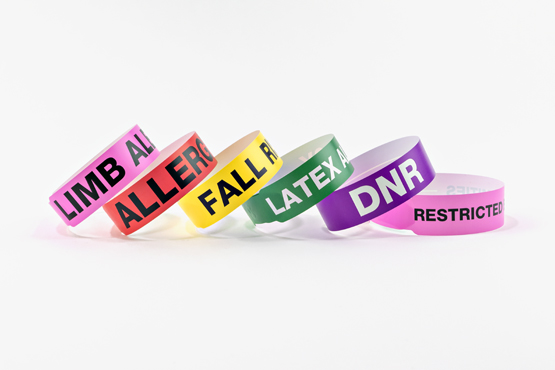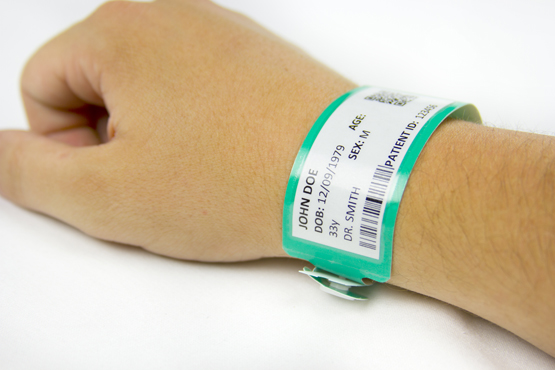Top Hospitals Worldwide Are Standardizing the Patient Identification Band—Here’s Why
Top Hospitals Worldwide Are Standardizing the Patient Identification Band—Here’s Why
Blog Article
The Duty of Individual Identification Band in Averting Medical Errors and Improving Results
In medical care, patient recognition bands are more than just wristbands; they're fundamental tools that help stop mistakes and enhance outcomes. When you assume concerning the risks involved in misidentification, it becomes clear just how essential these bands are in making certain client safety.
Recognizing Patient Identification Bands
Patient identification bands are necessary devices in medical care settings, ensuring that people obtain the proper therapies and drugs. These bands commonly include essential information, such as your name, day of birth, and a special identification number. When you reach a healthcare facility, employee rapidly check your band to match you with your medical documents, treatments, and recommended drugs.
Recognizing exactly how these bands work can enhance your experience and security. They not just function as a visual reminder for healthcare providers yet additionally assist to stop errors and mix-ups. You'll often see a barcode or QR code on the band, which permits quick electronic confirmation of your identification.
Value of Accurate Individual Recognition

Influence on Person Safety
When medical care experts can not dependably recognize individuals, the risk of errors enhances considerably, threatening security and therapy end results. Precise individual recognition is vital for supplying suitable treatment. Client identification bands serve as a basic yet reliable device to minimize these dangers.
Minimizing Medication Errors
When you put on a client identification band, medical care experts can easily validate your identity before providing any type of medication. It's important that you keep this band on throughout your keep, as it acts as a guard against potential blunders. Keep in mind, your security is a concern, and your identification band plays a considerable duty in guaranteeing you obtain the ideal therapy every time.
Enhancing Medical Process Performance
While person identification bands may look like a minor detail, they significantly boost clinical workflow effectiveness by simplifying processes within health care setups. When you properly recognize patients, you reduce delays and minimize the demand for repetitive checks. This allows you and your group to concentrate more on direct patient care rather than administrative tasks. With readable and clear bands, you can swiftly access important info, making sure that therapies and medicines are provided properly. These bands assist in smoother communication among healthcare providers, reducing complication and cultivating partnership. By integrating patient recognition bands right into your operations, you not just improve effectiveness but also add to much better client end results and contentment, making your job a lot more efficient and gratifying.
Common Medical Errors Linked to Misidentification
Misidentification can bring about major clinical errors that put people in danger. You might experience concerns like medication management errors, incorrect operations, or laboratory test false impressions - Patient Identification Band. Understanding these errors is crucial for improving individual safety and security and care
Medication Administration Errors
Medicine management errors are alarmingly typical in health care setups, with researches showing that nearly 1 in 5 individuals might experience a mistake because of misidentification. These mistakes can take place when a patient receives the wrong medication, dose, or management route since their identity isn't precisely validated. Think of getting a medicine meant for somebody else; the repercussions can be extreme, occasionally causing unfavorable reactions and even deaths.
Making use of a person recognition band especially lowers these dangers by making certain that doctor can swiftly validate your identity. When everyone entailed in your care is confident in that you are, the possibilities of obtaining the right medication rise substantially. This simple yet reliable tool plays an essential function in enhancing individual safety and enhancing overall health care outcomes.
Procedure Mistakes
Errors throughout procedures can have destructive impacts, often originating from the failing to accurately recognize clients. Envision undertaking surgical treatment only to uncover that the wrong treatment is performed on you. This headache circumstance often arises from misidentification, where surgical teams wrongly operate the wrong individual or body part. You might assume this is rare, however it takes place more frequently than you would certainly believe. Having a dependable individual recognition band can considerably decrease these errors. It aids guarantee that everyone included in your treatment is on the very same web page when you put on a band that plainly mentions your identification and procedure. By prioritizing accurate patient identification, you can help avoid surgical errors and improve results on your own and others.
Laboratory Examination Misconceptions
When you believe about the effect of patient misidentification, laboratory examination misinterpretations may not be the initial issue that comes to mind, but they can lead to severe wellness threats. Correctly determining individuals with accurate identification bands helps guarantee that lab tests are linked to the best person. By decreasing misidentification, you reduce the risk of damaging mistakes and enhance total person safety and outcomes.
Technologies Enhancing Client Recognition Bands
As health care proceeds to advance, technologies improving individual recognition bands are coming to be significantly essential for guaranteeing security and performance. You'll locate that developments like RFID (Superhigh Frequency Recognition) and NFC (Near Field Communication) innovation make client recognition bands a lot more trustworthy. These attributes enable fast scanning, minimizing the chances of misidentification.

Additionally, mobile applications that communicate with these bands can even more boost interaction among health care groups. By making use of these technologies, you can substantially reduce errors and boost individual end results. Accepting these innovations warranties that individual recognition bands remain a central component in your healthcare setting.
Applying Person Identification Methods
Executing robust individual identification methods is crucial for ensuring that every person gets the proper treatment immediately. Beginning by developing a standard process for patient identification at every touchpoint-- from admission to release. Usage 2 special identifiers, such as the individual's name and date of birth, to reduce errors.
Train your personnel thoroughly on these methods, highlighting the relevance of double-checking information prior to waging any type of therapy or medication (Patient Identification Band). my sources Regular audits can aid you determine gaps in conformity and locations for enhancement
Don't neglect to involve clients in the process. If something appears off, motivate them to verify their details and ask concerns. By fostering a society of safety and vigilance, you can assist avoid clinical errors and boost general patient results. Remember, each action you take in applying these procedures adds to a much safer medical care atmosphere for everyone included.
Situation Researches: Success Stories in Client Security
Success stories in client safety and security highlight the considerable influence of efficient person identification practices. In one health center, the implementation of color-coded wristbands caused a 40% decrease in drug errors. Staff rapidly acknowledged people' allergies and conditions, making sure secure therapies.
Another facility embraced barcode scanning for drug management, which substantially lowered adverse medication occasions. Nurses reported really feeling a lot more positive in their capability to confirm individual identifications and therapy strategies.
In a pediatric system, parents were associated with the identification process, causing boosted interaction and interaction. This partnership not only improved safety but also fostered trust in between families and medical care companies.
These examples show that when you focus on precise identification, you can considerably improve patient end results and security. Accepting these practices creates a society of watchfulness, eventually guaranteeing patients get the best treatment at the appropriate time, whenever.
Future Trends in Person Identification and Safety
With modern technology advancing swiftly, the future of client recognition and security is positioned for considerable transformation. You'll likely see an enhanced assimilation of biometric services, such as finger print or face recognition, making recognition faster and a lot more accurate. These techniques can aid eliminate mistakes caused by comparable names or miscommunication.
Artificial intelligence will certainly also play a crucial duty, evaluating individual data to flag prospective dangers and guarantee that security methods are followed constantly. Picture a system that signals you immediately if a person's details doesn't match their therapy plan.
In addition, wearable technologies may become commonplace, permitting real-time surveillance of person status and enhancing identification processes. As these advancements unravel, you'll discover that ensuring individual safety and security comes to be extra reliable and effective. Welcoming these fads suggests remaining ahead in the mission to decrease medical mistakes and boost total end results in health care.
Often Asked Questions
How Hold Your Horses Identification Bands Developed and Kept?
You produce client identification bands making use of details software program that produces distinct barcodes or QR codes. Frequently check and update the details to ensure accuracy, and train team on correct use to maintain performance with time.
What Materials Are Used in Person Identification Bands?
Patient recognition bands are commonly made from long lasting materials like plastic or plastic. You'll discover they're developed to withstand damage while making sure clear visibility of necessary information for doctor during therapy.
Can Clients Personalize Their Identification Bands?
Yes, you can commonly customize your identification bands, relying on the facility's plans (Patient Identification Band). Personalizing them with styles or shades might assist express your choices, making your experience feel much more comfy and unique throughout your treatment
How Commonly Should Patient Identification Bands Be Replaced?
You should replace client recognition bands whenever they come to be harmed, dirtied, or unreadable. Regular checks are important to ensure they're constantly clear and accurate, which assists preserve reliable interaction and safety and security throughout your treatment experience.
If a Band Is Damaged or Lost?, what Occurs.

If a band's damaged or lost, you need to inform go the medical care group quickly. They'll replace it to ensure accurate recognition, stopping possible mix-ups and making sure you get the proper treatment and drugs.
Individual identification bands are crucial tools in medical care setups, ensuring that patients obtain the correct treatments and drugs. By incorporating person recognition bands into your workflow, you not just boost performance however likewise contribute to better person end results and contentment, making your job much reference more efficient and gratifying.
You'll find that innovations like RFID (Radio Regularity Identification) and NFC (Near Field Interaction) technology make person recognition bands a lot more reliable.Implementing durable individual recognition protocols is important for guaranteeing that every patient obtains the right care without hold-up.Success stories in individual security highlight the substantial impact of efficient client recognition methods.
Report this page